Q&A: Daniel Lamarre talks about his two decades with Cirque du Soleil
Daniel Lamarre spent 20 years as CEO of Cirque du Soleil, and now he’s written a book that seeks to spark innovation in its readers, through personal and behind-the-scenes anecdotes revealing the highs, the lows, and the creativity that kept it all going.
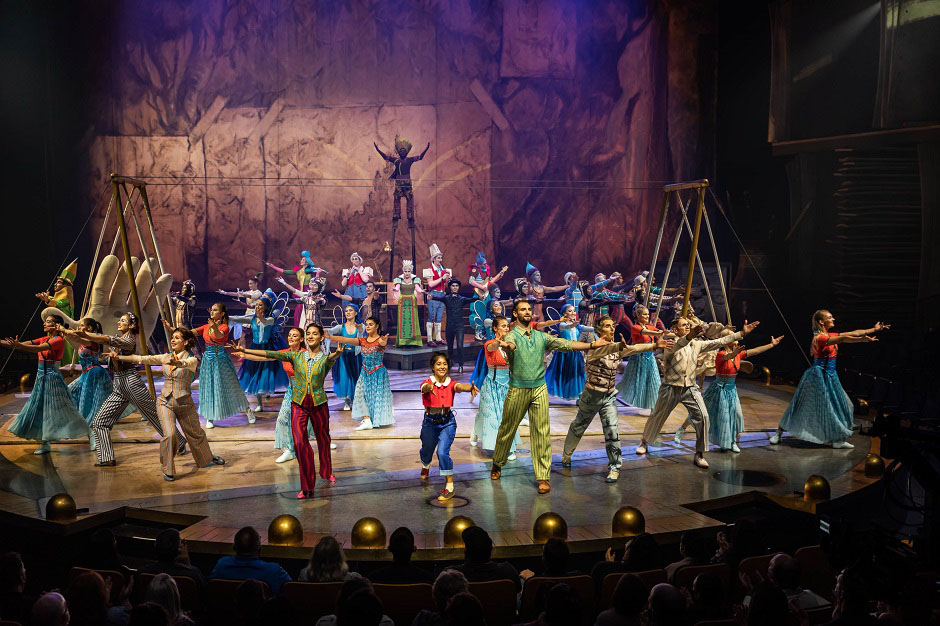
During the pandemic, all 44 Cirque du Soleil shows globally were shut down, and 95 percent of the company’s workforce was laid off. It was the most challenging time of his career for Daniel, but out of that challenge – and his 21 years with the company – his new book, “Balancing Acts,” was born.
Daniel shared his story with us:
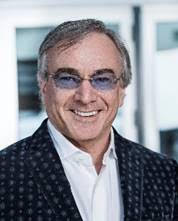
Can you tell us about how you got involved with Cirque du Soleil?
Before Cirque du Soleil I was the owner of the largest PR firm in Canada, and after that I moved to become the CEO of a television network in Canada. In the course of those two experiences, I got to know Guy Laliberté and typical Guy, he called me out of the blue one day while he was in London, and I was in my office at the TV network, and he said, “I had an amazing flash last night.” I said, “What was it?” Then he screamed, “You’re going to join the circus!” And here I am, 21 years later, having had the opportunity to work with him for 15 years, then work with different owners, and I’m still here, enjoying myself.
Was that a career change you ever thought you’d make?
I never thought I will end up here. That was a tough decision because I was at the time a traditional business guy, enjoying being the CEO of a television network, and I didn’t know anything about the entertainment world. That was a tough decision at the time, but by far the best decision of my life, because it made me enjoy immensely the challenge of traveling the world and building this amazing global brand.
It’s a unique opportunity to have the chance to work with such amazing creators and artists coming from all around the world. If you would walk into our creative studio in Montreal, you would have the feeling that you are in the United Nations building, because we have people from 90 different nationalities working for us.


With the background you had, did you have to learn to be untraditional?
That was the case. That’s why I wrote the book, because I found it was important for me to share with people my experience. The one thing I learned from those amazing creators – and I had the opportunity to observe our founder, Guy Laliberté, but also having the opportunity to work with creators from all over the world, working with the Beatles, working with James Cameron – so in observing those creators I discovered that maybe my life will be better fulfilled if I push my personal and professional boundaries of creativity, and that’s the learning I wanted to share with peoples.
You got a long way down the line with the book, and then the pandemic hit. Did everything change?
Oh my God, I will never forget that. On the famous “black Friday,” March 13, at the end of the day we had no more touring shows. I remember that night coming home and saying to my wife, “Vegas and Orlando are still open, and if they’re still open, we’re okay.” Resident shows are a sustainable business.
Then, Saturday, March 14, everything was shut down, and Vegas, the entire city, was shut down. I went from 44 shows to zero shows. From a billion dollars of revenue to no revenue. I would never, ever in my life have imagined such a nightmare. That was a horrible situation.
Needless to say, I called my publisher and said, “Forget about me writing a book. I would look stupid right now.” He said, “I guess you’re right, but if you just continue to work on your book, and you immerge from the crisis, maybe there will be more appeal for the book and maybe the book might be even more interesting.” That’s what we decided to do, and I’m happy I did that because right now I feel that some of the learnings I learned from the crisis could be helpful to other people.
What happened to the performers once the pandemic hit? Did they all have to go back to their own countries?
There are two categories of artists here. The artists from the resident shows – Vegas and Orlando – they live in the city, so that was not that bad. They could stay in their own home and continue to train and prepare for whenever we were able to come back.
For the touring people, that was a huge challenge for us, because within a few days we had to send them from wherever they were in the world to go back home. Within a few days, the boundaries for the countries were shut down. The airplane companies were shutting down their activities. So that was a huge challenge for us, to make sure all of our artists, cast, and crew will be back in their home city. We did that, but that was so tough.
“Drawn to Life” was just about ready to go on stage. Everything was set up, and the rug got pulled out from under you. Was that a particularly difficult aspect of the whole situation?
Yeah, it was, for sure. As a matter of fact, that was my last trip before the crisis, going to Orlando for a full dress rehearsal. We were in great shape, the show was about to open, and I was very excited about it. Then the crisis occurred and we had to keep all the cast and crew in town, and we did lose some because of the crisis. For instance, the Chinese crew had to go back, and we lost them, so we had to find other actors. But now the show is up and running, and in great shape, and I’m happy and proud of the success we’re having.
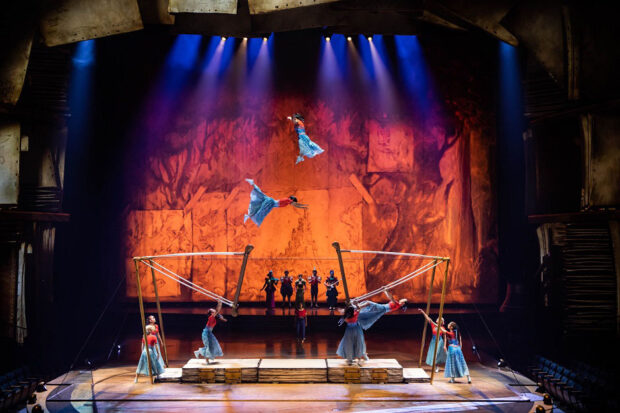
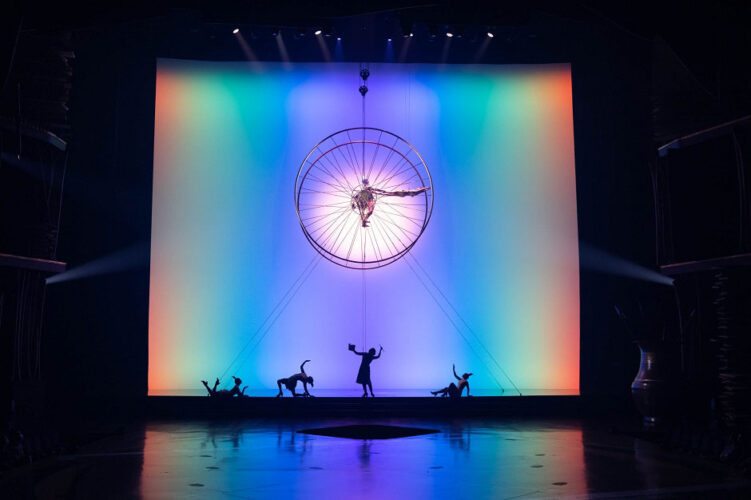
Was it difficult to get everybody back together after things began to open up again?
For the resident show, because they were living in the city, that was easier. We kept close to 90 percent of our artists. For the touring show it was tougher, even though we stayed in touch with them, because they were away. Having said that, it’s still a good number, because 75 percent of our artists came back, which was better than I expected after 15 months of no activity.
For “Drawn to Life,” were they able to continue to train so they didn’t lose what they had when they came back to the show?
They could continue to train, physically, but they could not rehearse in the theater. It was forbidden for many, many months. I was impressed that they were very creative in staying in shape. They were building their own apparatus and gyms in their garages and basements; they were grouping together to continue to train. That was really impressive, and probably the best good news of this crisis is that our artists were very disciplined and stayed in shape, because from one month to the next, we didn’t know when we would be able to open, so we told them, “Stay in shape, because we might call you tomorrow and say ‘Come back to the gym because we’re going to rehearse the show.’”
As soon as we were permitted to restart rehearsals in the theater in Orlando we jumped on the opportunity. We though we would have to spend a few weeks to make sure our artists were in shape, but after a couple of weeks they were ready to go. It was really encouraging. That’s why we have the quality of show we have now.
It says a lot about the professionalism of our artists. They are disciplined, because a lot of them are former Olympic athletes, there are people that have been training all their life, and that was, for me, an indication of how disciplined they are, and more importantly, how dedicated they are to whatever form of art they’re performing on stage.

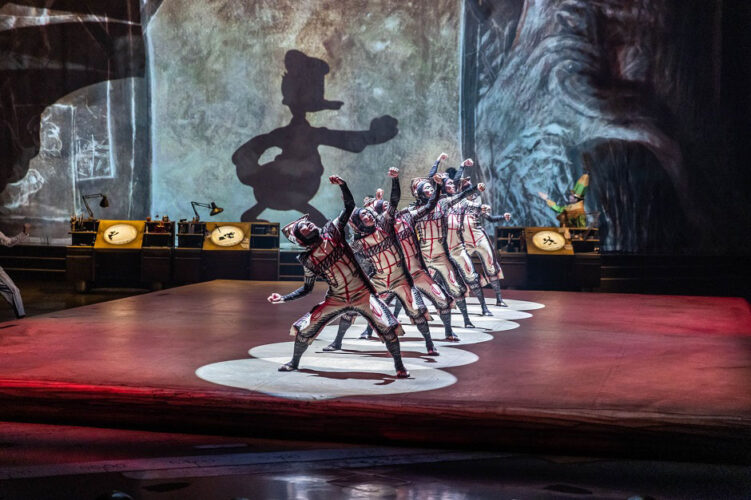
Can you share a lasting memory of your time with Cirque du Soleil, pre-pandemic?
The reality is, at the time, I was preparing myself to leave my position of CEO, and everything was going smoothly in the organization. “Drawn to Life” is very symbolic for me, because that was, for me, the ultimate achievement; to have the opportunity to work with the Disney IP, because “Drawn to Life” is a tribute to Disney animation. For me, that was the right way to leave the company, on a big, big high.
After the last year or so in Orlando, I was so excited. I said to myself, “I’m good now. I can leave. The company’s in good shape.” And then, boom. The crisis happened, and there was no way I could leave the ship. I had to stay for additional years.
When it did come time to leave, and you knew it was your last Cirque show, what was that like?
That was very special. That was symbolic. That was the right way. You always want to leave the company on a high. I had a strong feeling this show was the next big statement of Cirque du Soleil in terms of artistic content, and I felt very good about that. I had a huge sentiment of pride.
Your next step was to continue writing “Balancing Acts,” or was that almost done by the time you stepped down?
The crisis hit, and I said to the publisher, “We’ll continue writing during the crisis.” But I was not spending most of my time writing, I was spending most of my time trying to save the company. Unfortunately for me, I was spending too much time with lawyers, accountants, bankers, to try to convince people that this organization, which has a huge global brand and footprint, should continue to pursue its activities. I was adamant, convincing everybody that by the end of the crisis Cirque will rebound.
Just imagine the meeting, for a moment: You’re in front of lenders, and you owe them quite a bit of money. You’re saying to them, “We have no revenue right now, we have no activity at all, but believe in use because when we rebound, we will come back to the level that we were, and, by the way, we need $375 million in our bank account to relaunch our activities.”
So that was my pitch. Needless to say, I used more convincing arguments to support my pitch, but at the end of the day we got their support. That was a very rewarding experience.
And today, they’re very proud of their decision, because what I said was not a pitch, it was the reality. Because we’re back, and now they look great [because] they saved the [company’s] value, they’re shareholders of the company, and they’re happy with their investment.
Was there a time when Cirque du Soleil’s return was in doubt, even when the pandemic stopped?
The reality is, yes. But I never, ever accepted that thought. Every time that though popped up in my mind, I would fight back. I had to be convinced so I could convince others that not only will we come back, but we will come back very, very strong. I was so focused on saving the thousands of jobs of our employees that I was more focused on the fight than on being depressed by the situation I was going through.
In my 21 years at Cirque du Soleil, saving the company is probably the most rewarding experience I’ve been through. That’s why, today, I have a sentiment of relief. Our employees are back in the studio right now, and meeting with the artists is so rewarding.
The symbol of “Drawn to Life,” it’s the ultimate symbol for me, because when I was there, we opened the show and launched the show officially, to me that was, “Yes, Cirque is back.” That was such an emotional moment.
The reality is, I’m blessed, because last December [when] I proposed to the board the replacement CEO of the company, Stephane Lefebvre, who is a very good friend of mine, they asked me to stay as Executive Vice-Chairman for a few years, and it’s rewarding, because now I have my best friend taking over the CEO-ship and doing amazingly well. It’s a very small transition for the company, for him, and for myself, and now I have other big project to deliver for Cirque du Soleil, and that’s exciting. Now he’s managing the job on a day-to-day basis and I’m having a lot of fun building new shows that we have in the pipeline.

What was your inspiration for writing “Balancing Acts”?
My goal was, coming from the traditional business world, I truly believe that in the corporate world sometimes, people are limiting themselves. They’re limiting themselves by not being creative enough, and that’s what I’ve learned in observing amazing creators, that if you nurture your creativity you’ll innovate more. Because when we talk about innovation, what are we talking about? We’re talking about someone that is very creative. It’s either Steve Jobs, or Elon Musk, and those creative minds innovate by their creativity, because they are pushing the boundaries of their own creativity.
I’ll never forget when Elon Musk came to see one of our shows in Los Angeles. He wanted to know everything about our creative process, about our technology. And I went through a similar experience when James Cameron came to our creative studio in Montreal. He spent hours raising questions about how do we do this, how do we do that. The creativeness of those guys are how they become not only visionaries, but innovators in their own field.
What do you hope people take away from the book?
That they will be inspired to be more creative, not only professionally but also personally. In my opinion, we’re beasts of habit, and we don’t reflect enough. We don’t take the 30 minutes or the hour in a day and say, okay, what am I going to do today to change the world, or to change my world. You need to think about it. I hope people will be inspired to do that, and say, “What am I going to do to improve my performance, or to have more fun in life?” Those are the kind of things I hope people will come up with their own outcome.
Sometimes you say something and someone listens to what you said, but something will click in their minds that has nothing to do with what you said. They say, “Okay! Now I have the solution to my problem!” or “Now I have a good idea that I’m going to pursue.” That’s the kind of “click” I hope this book will provoke in the minds of people.
How do you describe Cirque du Soliel to someone who has never seen a show?
You will probably start by saying, “It’s not a circus, it’s not theatrical, it’s not music, it’s not dance.” Then, my take will be as it’s written in the Blue Ocean strategy by two teachers of Harvard Business School, that says, “Cirque du Soleil has invented a category of show.” And that’s what I think.
I think we have done a breakthrough, and this breakthrough remains at the epitome of the entertainment world, and now the challenge is to be more creative, and come up with innovative shows that will continue to create emotions on our patrons, and make them laugh. And, more importantly, to get them surprised. Because our challenge is to surprise our fan. We have to surprise them with coming up with new acts, new innovative performance, new innovative artistic content.
What’s next for you?
I will support the new CEO, because I have a privileged relationship with Disney, and with MGM in Vegas and promotors around the world, so I will continue to travel the world and support him in growing the company. I also hope to have more time to talk to students in universities, and entrepreneurs, to spark their creativity.
You can find Daniel Lamarre’s book, Balancing Acts, on HarperCollins Balancing Acts page, through Barnes & Nobel, Amazon.com, and at local booksellers near you.

